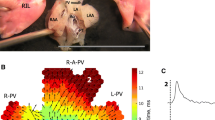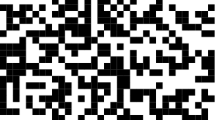Abstract
Background
The purpose of this study was to investigate the effect of cholinergic modulation in the presence of increased adrenergic tone (i. e., autonomic fluctuation) on atrial tachyarrhythmia (AT) induction.
Methods and results
High-resolution optical mapping was used to measure action potentials from the left atrium in isolated arterially perfused canine atrial preparations. Optical recordings were made in the presence of isoproterenol during electrical stimulation of a fat pad at the right pulmonary veinatrial junction (Group I, n = 6), during electrical stimulation of a fat pad locating the superior vena cava contacted by the right pulmonary artery (Group II, n = 4), and during acetylcholine (ACh; Group III, n = 4) infusion. In the presence of isoproterenol,each of the three different transitory cholinergic interventions induced spontaneous AT in all preparations. In Group I, AT induced from the right atrium was sustained. However, AT induced from the left atrium was not sustained (RRB) in Group I. In Groups II and III, AT induced from the left atrium as well as the right atrium were also sustained (BAF-AT). The A1A2 coupling interval was shorter when BAF-AT was induced than it was when RRB was induced. Mean cycle length of repetitive focal excitation was shorter during the initiation of BAF-AT compared to RRB. Isochrone maps during the initiation of AT demonstrated a macroreentry with lines of conduction block following a single extrasystole (27 %) and focal repetitive excitation (73 %).
Conclusions
These results suggest that transitory cholinergic activation in the presence of increased adrenergic drive in the left atrium causes a single premature extrasystole with a short coupling interval and a focal repetitive excitation with a short cycle length, which favors the generation of AT originating from the left atrium.
Similar content being viewed by others
References
Arora R, Verheule S, Scott L, Navarrete A, Katari V, Wilson E, Vaz D, Olgin JE (2003) Arrhythmogenic substrate of the pulmonary veins assessed by high-resolution optical mapping. Circulation 107:1816–1821
Bettoni M, Zimmermann M (2002) Autonomic tone variations before the onset of paroxysmal atrial fibrillation. Circulation 105:2753–2759
Burashnikov A, Antzelevitch C (2003) Reinduction of atrial fibrillation immediately after termination of the arrhythmia is mediated by late phase 3 early afterdepolarization-induced triggered activity. Circulation 107:2355–2360
Chen SA, Hsieh MH, Tai CT, Tsai CF, Prakash VS, Yu WC, Hsu TL, Ding YA, Chang MS (1999) Initiation of atrial fibrillation by ectopic beats originating from the pulmonary veins: electrophysiological characteristics, pharmacological responses, and effects of radiofrequency ablation. Circulation 100:1879–1886
Chen YJ, Chen SA, Chen YC, Yeh HI, Chang MS, Lin CI (2002) Electrophysiology of single cardiomyocytes isolated from rabbit pulmonary veins: implication in initiation of focal atrial fibrillation. Basic Res Cardiol 97:26–34
Chen YJ, Chen SA,Tai CT, Wen ZC, Feng AN, Ding YA, Chang MS (1998) Role of atrial electrophysiology and autonomic nervous system in patients with supraventricular tachycardia and paroxysmal atrial fibrillation. J Am Coll Cardiol 32:732–738
Chiou CW, Eble JN, Zipes DP (1997) Efferent vagal innervation of the canine atria and sinus and atrioventricular nodes. The third fat pad. Circulation 95:2573–2584
Coumel P (1996) Role of the autonomic nervous system in paroxysmal atrial fibrillation. In: Touboul PC, Waldo AL (eds) Atrial Flutter. Armonk, NY: Futura Publishing Co, pp 248–161
Fioranelli M, Piccoli M, Mileto GM, Sgreccia F,Azzolini P, Risa MP, Francardelli RL, Venturini E, Puglisi A (1999) Analysis of heart rate variability five minutes before the onset of paroxysmal atrial fibrillation. Pacing Clinical Electrophysiol 22:743–749
Haissaguerre M, Jais P, Shah DC, Takahashi A, Hocini M, Quiniou G, Garrigue S, Le Mouroux A, Le Metayer P, Clementy J (1998) Spontaneous initiation of atrial fibrillation by ectopic beats originating in the pulmonary veins. N Engl J Med 339:659–666
Hirose M, Carlson MD, Laurita KR (2002) Cellular mechanisms of vagally mediated atrial tachyarrhythmia in isolated arterially perfused canine right atria. J Cardiovasc Electrophysiol 13: 918–926
Hirose M, Laurita KR (2003) Triggered activity is an underlying mechanism of PACAP-induced atrial fibrillation. Circulation 106 (Suppl II):II-178 Abstract
Hirose M, Leatmanoratn Z, Laurita KR, Carlson MD (2001) Mechanism for pituitary adenylate cyclase-activating polypeptide-induced atrial fibrillation. J Cardiovasc Electrophysiol 12: 1381–1386
Laurita KR, Girouard SD, Rosenbaum DS (1996) Modulation of ventricular repolarization by a premature stimulus: role of epicardial dispersion of repolarization kinetics demonstrated by optical mapping of the intact guinea pig heart. Circ Res 79:493–503
Levy MN (1971) Sympathetic-parasympathetic interactions in the heart. Circ Res 29:437–445
Liu L, Nattel S (1997) Differing sympathetic and vagal effects on atrial fibrillation in dog: role of refractoriness heterogeneity. Am J Physiol 273:H805–H816
Pappone C, Santinelli V, Manguso F, Vicedomini G, Gugliotta F, Augello G,Mazzone P, Tortoriello V, Landoni G, Zangrillo A, Lang C, Tomita T,Mesas C, Mastella E, Alfieri O (2004) Pulmonary vein denervation enhances long-term benefit after circumferential ablation for paroxysmal atrial fibrillation. Circulation 109:327–334
Patterson E, Lazzara R, Szabo B, Liu H, Tang D, Li YH, Scherlag BJ, Po SS (2006) Sodium-calcium exchange initiated by the Ca2+ transient. J Am Coll Caldiol 47:1196–1206
Patterson E, Po SS, Scherlag BJ, Lazzara R (2005) Triggered firing pulmonary veins initiated by in vitro autonomic nerve stmulation. Heart Rhythm 2:624–631
Randall WC, Milosavljevic M, Wurster RD, Geis GS, Ardell JL (1986) Selective vagal innervation of the heart. Ann Clin Lab Sci 16:198–208
Schauerte P, Scherlag BJ, Pitha J, Scherlag MA, Reynolds D, Lazzara R, Jackman WM (2000) Catheter ablation of cardiac autonomic nerves for prevention of vagal atrial fibrillation. Circulation 102:2774–2780
Schuessler RB, Grayson TM, Bromberg BI, Cox JL, Boineau JP (1992) Cholinergically mediated tachyarrhythmias induced by a single extrastimulus in the isolated canine right atrium. Circ Res 71:1254–1267
Schuessler RB, Rosenshtraukh LV, Boineau JP, Bromberg BI, Cox JL (1991) Spontaneous tachyarrhythmias after cholinergic suppression in the isolated perfused canine right atrium. Circ Res 69:1075–1087
Sharifov OF, Fedorov VV, Beloshapko GG, Glukhov AV, Yushmanova AV, Rosenshtraukh LV (2004) Roles of adrenergic and cholinergic stimulation in spontaneous atrial fibrillation in dogs. J Am Coll Cardiol 43:483–490
Sharifov OF, Zaitsev AV, Rosenshtraukh LV, Kaliadin AY, Beloshapko GG, Yushmanova AV, Schuessler RB, Boineau JP (2000) Spatial distribution and frequency dependence of arrhythmogenic vagal effects in canine atria. J Cardiovasc Electrophysiol 11:1029–1042
Volders PGA, Kulcsar A, Vos MA, Sipido KR, Wellens HJJ, Lazzara R, Szabo B (1996) Similarities between early and delayed afterdepolarizations induced by isoproterenol in canine ventricular myocytes. Cardiovasc Res 34:348–359
Yamada KA, Corr PB (1992) Effects of b-adrenergic receptor activation on intracellular calcium and membrane potential in adult cardiac myocytes. J Cardiovasc Electrophysiol 3:209–224
Zimmermann M, Kalusche D (2001) Fluctuation in autonomic tone is a major determinant of sustained atrial arrhythmias in patients with focal ectopy originating from the pulmonary veins. J Cardiovasc Electrophysiol 12:285–291
Author information
Authors and Affiliations
Corresponding author
Rights and permissions
About this article
Cite this article
Hirose, M., Imamura, H. Mechanisms of atrial tachyarrhythmia induction in a canine model of autonomic tone fluctuation. Basic Res Cardiol 102, 52–62 (2007). https://doi.org/10.1007/s00395-006-0611-6
Received:
Revised:
Accepted:
Published:
Issue Date:
DOI: https://doi.org/10.1007/s00395-006-0611-6




